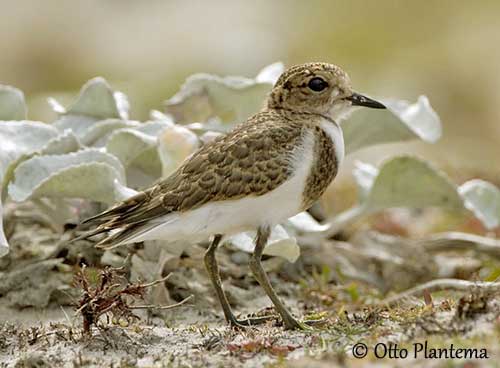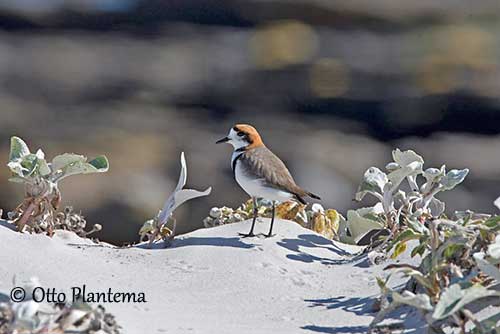
Fr: Pluvier ou Gravelot des Falkland
All: Falkland-Regenpfeifer
Esp: Chorlitejo Malvinero, Chorlitejo de las Malvinas, Chorlito doble collar, Chorlo de doble collar
Ita: Corriere delle Isole Falkland
Nd: Falklandplevier
Sd: Falklandpipare
Port: Batuíra-de-coleira-dupla
Photographers:
John Anderson
John Anderson Photo Galleries
Ken Havard
My Bird Gallery & Flickr gallery 1 & Flickr gallery 2
Eduardo Andrés Jordan
MIS AVES – AVES DE ARGENTINA
Otto Plantema
Trips around the world
Text by Nicole Bouglouan
Sources:
HANDBOOK OF THE BIRDS OF THE WORLD Vol 3 by Josep del Hoyo-Andrew Elliott-Jordi Sargatal - Lynx Edicions - ISBN : 8487334202
SHOREBIRDS by Peter Hayman, John Marchant and Tony Prater – Christopher Helm – 1986 – ISBN: 0747014035
BirdLife International (BirdLife International)
Birding Patagonia – Adventure expeditions
Two-banded Plover
Charadrius falklandicus
Charadriiformes Order – Charadriidae Family
INTRODUCTION:
The Two-banded Plover is a South American endemic species. This species is common along the shores of small pools and on coastal beaches.
There is a separate and sedentary population in Falkland Islands, but in spite of some difference in breast pattern, these birds are included in this monotypic species.

DESCRIPTION OF THE BIRD:
Biometrics:
Length: 17-18,5 cm
Weight: 62-72 g
The adult male in breeding plumage has pale chestnut crown and hindneck. The upperparts are grey-brown. On the upperwing, there is a relatively short, narrow white wingbar, mainly visible in flight, like the white tail-sides.
On the white underparts, we can see two black breast bands. The upper band is often broken, especially in Falkland’s birds. The lower one is broader and crescent-shaped. Underwing-coverts and axillaries are white.
On the head, the white forehead and lores contrast with narrow, black frontal band. The ear-covert’s area is blackish and often joins the upper breast band on neck side.
The bill is black. The eyes are dark brown. Legs and feet are black.
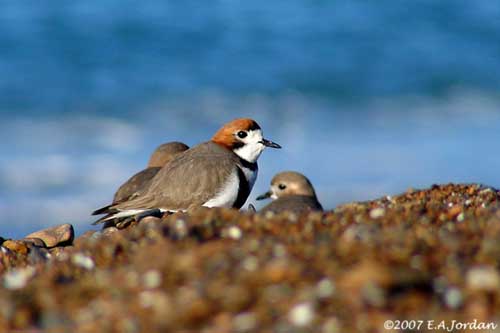
The female resembles male but the black areas are washed brownish. Crown and hindneck are duller rufous. The upperbreast band is narrower and flecked white.
The non-breeding adult has black areas replaced by grey, and crown and hindneck are grey-brown. Lores are duller, slightly pale greyish.
The juvenile is similar to non-breeding adult, but the breast bands are brown with buff fringes. It has darker face. The uppertail feathers are edged pale buff.
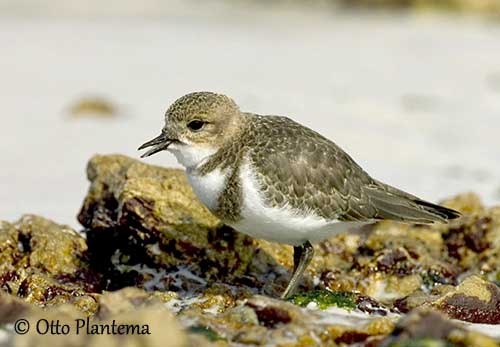
RANGE:
The Two-banded Plover breeds in C and S Chile and Argentina, and locally in Brazil.
The mainland population winters northwards to N Chile, Uruguay and S Brazil.
The Falkland’s population is sedentary.
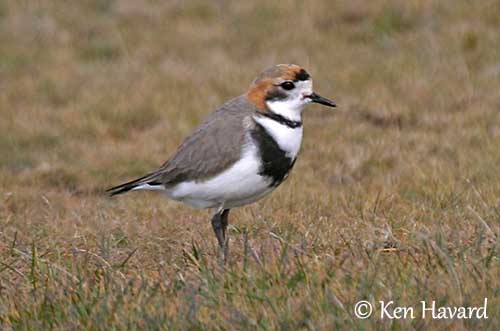
HABITAT:
The Two-banded Plover breeds on coastal beaches, riverbanks, along the shores of fresh or brackish pools, in wet savannas and near streams in lowlands.
Outside the breeding season, they can be found in flocks of up to 150 individuals or more on sandy beaches and intertidal mudflats.
Several birds breed up to 1200 metres of elevation on Andean foothills in S Argentina.
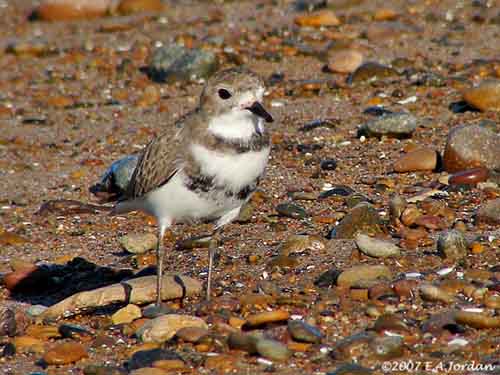
CALLS AND SONGS: SOUNDS BY XENO-CANTO
The Two-banded Plover gives thin “tseet” as contact call when on the ground.
While flying, it utters a more plaintive, liquid whistle “whiit” or “prit”. During the flight displays, we can hear less plaintive calls given in rapid succession, like a loud twittering whistle.
BEHAVIOUR IN THE WILD:
The Two-banded Plover feeds on small invertebrates such as arthropods, worms, larvae and crustaceans. It may venture into very shallow water for small preys.
It forages in beds of rotting kelp, also around the short-grassy edges of freshwater pools.
In Falkland Islands, it feeds on insects and other invertebrates while foraging among the coastal vegetation, in seaweeds and rock pools.
The feeding areas are often defended during winter.
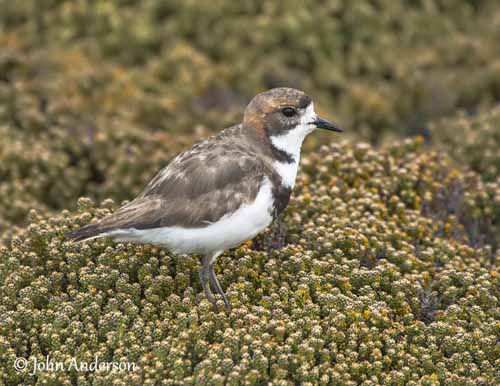
During the breeding season, The Two-banded Plover performs spectacular flight displays, with irregular dashes in all directions. They also perform aerial chases.
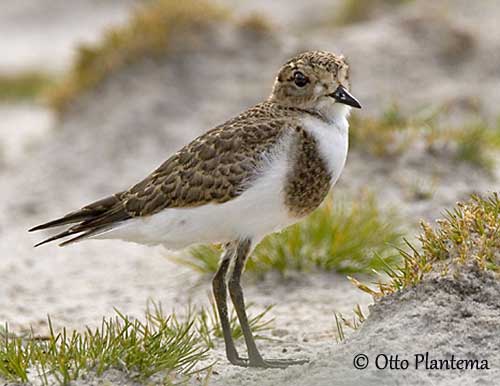
The Two-banded Plovers, adults and chicks, are able to run quickly. However, it performs beautiful flight displays and it is a strong flier. In flight, the tip of the toes projects just beyond the tail-tip.
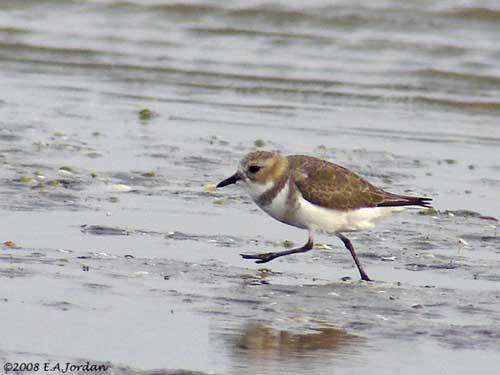
REPRODUCTION OF THIS SPECIES:
The laying occurs between September and December, later in upland habitats.
The nest is a shallow scrape on the ground, in grassland or in health. The pair nests solitary.
The female lays 2-4 buffy-olive eggs with brown markings. The incubation lasts about 28 days. The chicks have pale buff down with black speckles and lines on the upperparts. They leave the nest very soon and can be seen running quickly along the beach under the protection of the adults.
The parents may perform distraction displays, like an injured bird, to lure away any danger to the chicks.
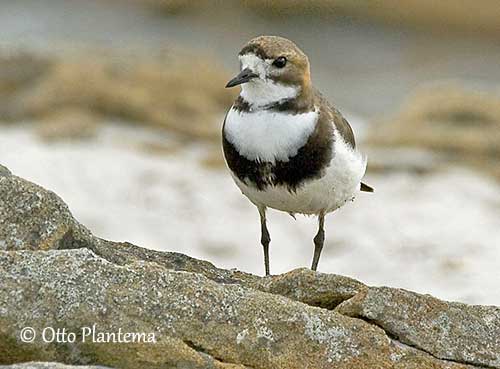
PROTECTION / THREATS / STATUS:
The Two-banded Plover is very common throughout the Falklands where about 10,000 breeding pairs are sedentary. Their local name is “Beach Lark”.
The overall population trend appears to be stable, and this species is not currently threatened, and evaluated as Least Concern.
